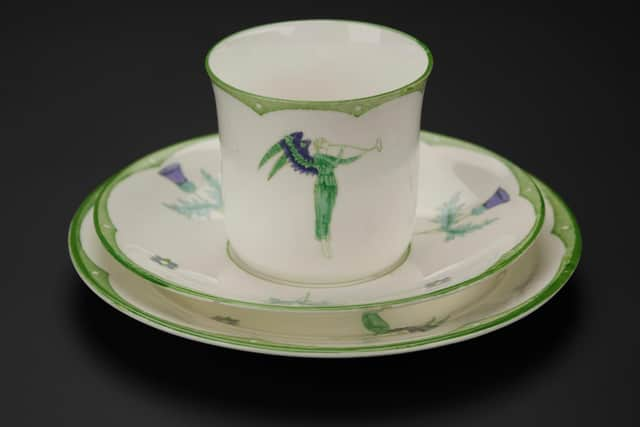The 'radical' tea set served by Glasgow suffragettes acquired for the nation
The bone china teacup, plate and saucer was made for the refreshment stall at the Grand Suffrage Bazaar and Exhibition at Charing Cross Halls in April 1910.
Painted in Suffragette colours of purple and green, the tea set carries the ‘angel of freedom’ design – created by artist and campaigner Sylvia Pankhurst – and a number of thistles.
Advertisement
Hide AdAdvertisement
Hide AdThe angel of freedom became the symbol of the Women’s Social and Political Union, the more militant wing of the women’s suffrage movement who turned to direct action in order to push for progress.


Claire Blakey, Curator of Modern Decorative Arts at National Museum of Scotland (NMS), which has acquired the tea set, said ceramics had a long history of being used to show support for particular causes.
Ms Blakey, writing in an article for NMS, said: "Teacups and saucers are probably not top of the list when we think about symbols of political and social protest.
"However, ceramics have a long history of being used to show support for a particular cause and in 18th century Britain, your choice of teapot could express your support for a radical politician. By the early 20th century, a tea service could be used to show support, and even raise funds, for women’s rights.
Ms Blakey added: “Drinking and serving tea from the WSPU tea sets was a polite way to show allegiance to the cause of women’s suffrage. It allowed an individual to start a conversation over a nice cup of tea with those yet to be convinced.
"Tea drinking had been a socially acceptable pastime for women since the 18th century and the equipment associated with it had long been used to make political points.”
The WSPU was founded by Pankhurst along with her mother Emmeline and sister Christabel in 1903.
A branch of the WSPU was formed in Glasgow in 1906, with the thistles especially added for the 1910 event to celebrate its Scottish members.
Advertisement
Hide AdAdvertisement
Hide AdThe ‘angel of freedom’, who appears in long flowing robes and carrying a clarion, also appeared on badges, banners and campaign literature and became a key visual symbol for the movement.
The curator added: “Raising funds was a vital part of the WSPU’s activities as they were needed to print campaigning material, pay full-time organisers and to organise meetings.
"Fundraising bazaars were a good way to do this, allowing members to sell hand-made or donated items, as well as WSPU merchandise. The refreshment stall was at the heart of the bazaars, serving tea and often raising the most funds.”
Bakery goods, millinery and WSPU tea were also sold at such bazaars.
Ms Blakey added: “At the end of the Bazaar, souvenirs such as this trio were sold to raise additional funds. In 1910, a breakfast set for two was advertised for 11 shillings, with a whole tea set at £2. As well as raising vital funds, these ceramics allowed suffragettes and their supporters to take their political message into the domestic sphere.”
Claire Blakey’s full article can be read on the NMS website.
A message from the Editor:Thank you for reading this article. We're more reliant on your support than ever as the shift in consumer habits brought about by coronavirus impacts our advertisers.
If you haven't already, please consider supporting our trusted, fact-checked journalism by taking out a digital subscription.
Comments
Want to join the conversation? Please or to comment on this article.
